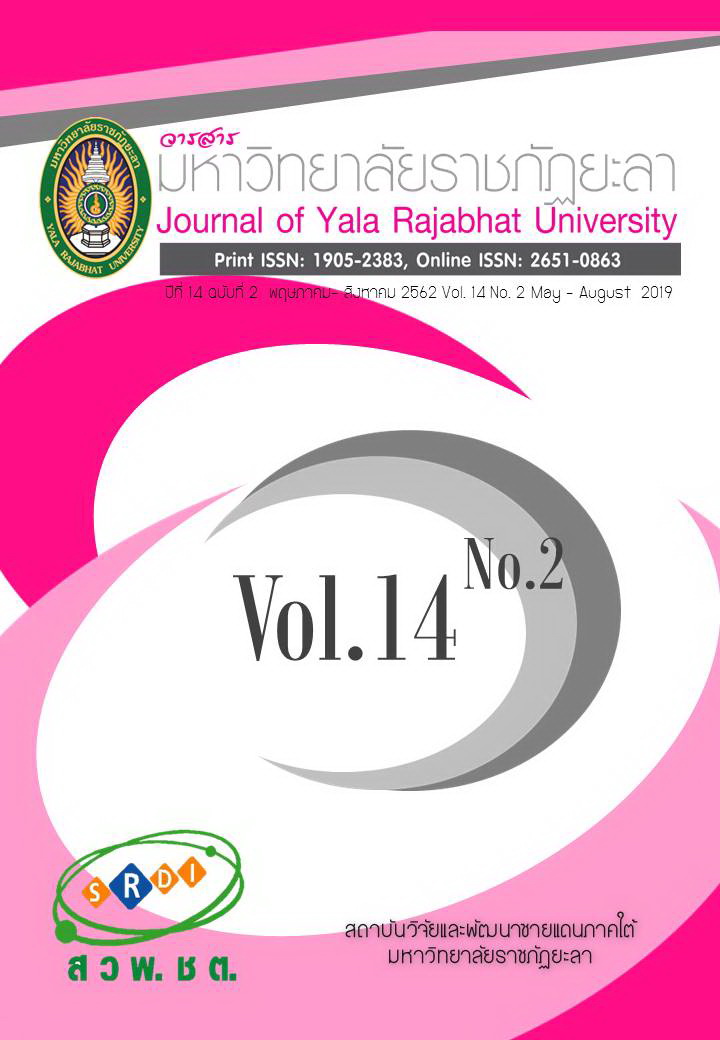การพัฒนารูปแบบการจัดการเรียนรู้ตามแนวคิดเชื่อมโยงนิยมเพื่อส่งเสริมการรู้สารสนเทศ
Main Article Content
บทคัดย่อ
การวิจัยครั้งนี้มีวัตถุประสงค์ 1)เพื่อสำรวจสภาพปัจจุบันปัญหา และความต้องการในการจัดการเรียนรู้ตามแนวคิดเชื่อมโยงนิยมเพื่อส่งเสริมการรู้สารสนเทศ 2) เพื่อพัฒนารูปแบบการจัดการเรียนรู้ตามแนวคิดเชื่อมโยงนิยมเพื่อส่งเสริมการรู้สารสนเทศ และ 3) เพื่อประเมินรูปแบบการจัดการเรียนรู้ตามแนวคิดเชื่อมโยงนิยมเพื่อส่งเสริมการรู้สารสนเทศ เก็บรวบรวมข้อมูลโดยศึกษาเอกสารงานวิจัย การสอบถามความคิดเห็นของครูผู้สอนรายวิชาสารสนเทศและการสื่อสาร จำนวน 168 คน จากผู้เชี่ยวชาญ จำนวน 8 คน เครื่องมือที่ใช้ในการวิจัยคือ แบบสำรวจความคิดเห็นต่อสภาพปัจจุบันและความต้องการในการจัดการเรียนรู้เพื่อส่งเสริมการรู้สารสนเทศ รูปแบบการจัดการเรียนรู้ตามแนวคิดเชื่อมโยงนิยมเพื่อส่งเสริมการรู้สารสนเทศ แบบประเมินรูปแบบการจัดการเรียนรู้ตามแนวคิดเชื่อมโยงนิยมเพื่อส่งเสริมการรู้สารสนเทศ ผลการวิจัยพบว่า 1) สภาพปัจจุบัน ปัญหา และความต้องการในการจัดการเรียนรู้ตามแนวคิดเชื่อมโยงนิยมเพื่อส่งเสริมการรู้สารสนเทศ ครูผู้สอนมีระดับการปฏิบัติในระดับปานกลาง ( =3.01,S.D.=0.77) มีความต้องการในการจัดการเรียนรู้ ในระดับ มาก ( =4.44, S.D.=0.79) 2) รูปแบบการจัดการเรียนรู้ตามแนวคิดเชื่อมโยงนิยมเพื่อส่งเสริมการรู้สารสนเทศ (5S Model) ประกอบด้วยการจัดการเรียน 5 ขั้นตอน คือ 1) Start ระบุประเด็นที่ต้องการหาคำตอบ 2) Search สำรวจและค้นหา 3) Self-Assessment ประเมินสารสนเทศ 4) Show แลกเปลี่ยนผลการประเมินข้อมูล 5) Share ตัดสินใจเลือกข้อมูลและสรุปผล 3) ประเมินรูปแบบการจัดการเรียนรู้ด้านองค์ประกอบ มีความเหมาะสมอยู่ในระดับ มากที่สุด ( =4.92, S.D.=0.09) ส่วนขั้นการจัดการเรียนรู้ตามแนวคิดเชื่อมโยงนิยมเพื่อส่งเสริมการรู้สารสนเทศ มีความเหมาะสมในระดับมากที่สุด ( =4.91, S.D.= 0.15)
Article Details
บทความ ข้อมูล เนื้อหา รูปภาพ ฯลฯ ที่ได้รับการเผยแพร่ในวารสารมหาวิทยาลัยราชภัฏยะลานี้ ถือเป็นลิขสิทธิ์ของวารสารมหาวิทยาลัยราชภัฏยะลา หากบุคคลหรือหน่วยงานใดต้องการนำทั้งหมดหรือส่วนหนึ่งส่วนใดไปเผยแพร่ต่อหรือกระทำการใดๆ จะต้องได้รับอนุญาตเป็นลายลักษณ์อักษรจากวารสารมหาวิทยาลัยราชภัฏยะลาก่อนเท่านั้น
References
2. Downes, S. (2015). Commentary by Stephen Downes on: Preparing for the digital university: A review ofthe history and current state of distance, blended , and online learning [Online]. RetrievedNovember 2, 2015, from: https://www.downes.ca/cgi-bin/page.cgi?post=63823.
3. Jakchum, C. (2016). The Development of a Training Program Based on Blended Learning for Enhancing Teacher’s Competency on Using Information and Communication Technology in LearningManagement. Journal of Yala Rajabhat University, 11(2),131. (in Thai)
4. Kaewurau, R. & Moundet, S. (2014). The 8 Steps of a Project-Based Learning with Social Media to Enhance 21st Century Skills. Educational Technology and Media Convergence Journal, 1(1),15-16. (in Thai)
5. Khlaisang, J. (2017). Production and Use of Systematic Media for 21st Century Learning Bangkok: Chulalongkorn University Printing House.(in Thai) Bangkok: Chulalongkorn University Printing House.(in Thai)
6. Dunaway, K. M . (2011) .Connectivism: Learning theory and pedagogical practice for networked information landscapes. Reference Services Review, 39 (4),pp.675-685.
7. Panich V. (2012). 21st Century Skills: The way how students learn. Bangkok: Sodsri-Saidwongso Foundation. (in Thai)
8. Siemens, G. (2004). Connectivism: A Learning Theory for the Digital Age [Online] Retrieved November 2, 2015, from: https://www.elearnspace.org/Articles/connectivism.
9. Sitti, S. (2014).The Web-based Instruction Model Based on Connectivism Learning Theory to Enhance Ploblem-solving Skill in Information and Communications Technology of Higher Education Students. Doctoral of Education Thesis, Educational Technology and Communications, Kasetsart University. (in Thai)
10. Sungpum, W. (2008). Instruction Model based on Connectivism Theory. Journal of Vocational and Technical Education, 1(2), 50. (in Thai)
11. Suwan, S. (2008). Information literacy instruction in secondary schools in Bangkok Metropolis Area. Journal of Pathumthani University, 3(3), 213. (in Thai)
12. Techataweewan, W., Worrapanya, K. & Sanrach, C. (2008). Integrating Information Literacy into Student- Centered Learning Management System. Journal of Humanities, 30(2), 43-64.(in Thai)
13. Tunhikorn, B. (2008). Application of information technology in teaching and learning. Bangkok: The Information Technology Foundation under the Initiative of Her Royal
Highness Princess Maha Chakri Sirindhorn. (in Thai)
14. Wongkitrungruang, W. & Jittarurk, A. (2008). 21st Century Skills: Rethinking How Students Learn. Bangkok: Open World Printing . (in Thai)

